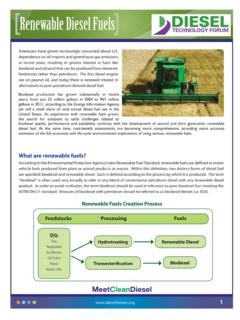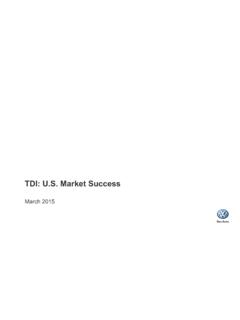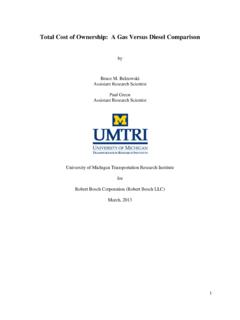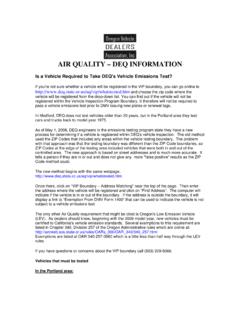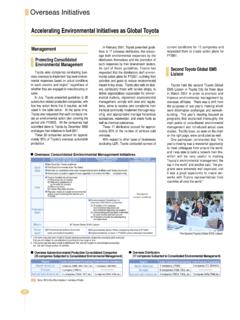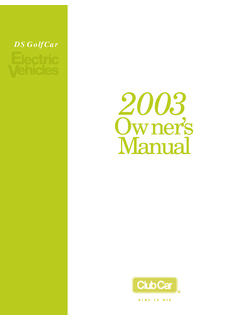Transcription of CLEAN DIESEL TECHNOLOGY
1 CLEAN DIESEL TECHNOLOGY is now the standard for all new TECHNOLOGY , everything from new passenger cars and pick-up trucks to highway commercial trucks. CLEAN DIESEL is a system of three key parts: cleaner DIESEL fuel, advanced engine TECHNOLOGY and aftertreatment. Now, starting in 2011, this new generation of CLEAN DIESEL TECHNOLOGY for off-road engines and equipment known as Tier 4 will be making its way onto the construction and industrial jobsites and farm fields around the country. This paper describes the milestones and TECHNOLOGY and what it means for dealers, distributors, mechanics and those involved with operating DIESEL engines and 4 off-road CLEAN DIESEL DIESEL TECHNOLOGYFOR OFF-ROAD ENGINES AND EQUIPMENT: TIER 4 AND MORE tier 4 off-road CLEAN DIESEL IS TIER 4?Tier 4 refers to a generation of federal air emissions standards established by the Environmental Protection Agency (EPA) that apply to new DIESEL engines used in off-road equipment.
2 Essentially it requires manufacturers to reduce the levels of particulate matter and oxides of nitrogen (NOx) to a level that is 50-96 percent lower than existing generation of DIESEL engines. It is important to note that Tier 4 emissions requirements apply to new products only and do not apply retroactively to any existing machines or equipment. (See section on retrofit). EPA and California have adopted the same standards, so there are no unique Tier 4 DIESEL emissions standards that apply in California. WHY ARE THESE CHANGES BEING MADE?Through the CLEAN Air Act, EPA establishes national CLEAN air standards that determine levels of allowable emissions (ozone, fine particles, etc.) in the air. From that, sources of these emissions (cars, trucks, tractors, power plants, other industry) are regulated by EPA and the California Air Resources Board to control the volume and types of emissions. Each state or regional area with levels of emissions that exceed the standards must develop a plan to improve air quality and meet the CLEAN air requirements established by EPA.
3 Introducing new cleaner DIESEL engines will aid in state and regional CLEAN air >figure 1: Emissions Standards for Bulldozerstier 4 off-road CLEAN DIESEL WERE THE TIERS ESTABLISHED? WHAT ARE THE OTHER TIERS? The tiered series of emissions regulations has been in effect over the last 13 years governing new off-road engines and equipment. These standards establish progressively lower allowable emissions of nitrogen oxides and particulate matter. It is complex system and its compliance dates are based on the size of engine (in hp and /kW-hr) and other factors. The Tier 4 standards provide manufacturers with a flexibility provision and include an interim step - Tier 4 interim - which requires substantial reduction in PM emissions and flexibility in lowering oxides of nitrogen. A Tier 4 final step includes additional reductions in NOx and HC emissions. A detailed table (Figure 3) of these standards along with a graphical display is in the Appendix.
4 A Tier 0 engine has basically no modern emissions controls and may be referred to as unregulated and is likely to be a mechanically controlled engine rather than electronic. Each progression of standard level - Tier 1, Tier 2, Tier 3 engines all are lower in emissions and more advanced technologically than the previous generation. The use of electronic engine controls, new higher pressure fuel injection systems and advanced turbocharging are all technologies that reduce emissions and aid performance. ONCE THE TIER 4 ENGINES COME ON THE MARKET, CAN I STILL ORDER A TIER 3 ENGINE? According to federal law and EPA regulations, depending on the machine, manufacturers will typically only be able to produce the Tier 4 engines after the established deadlines. However, equipment dealers can sell inventories of engines and equipment from the previous generation TECHNOLOGY (Tier 3) until the inventory is depleted. Each engine and equipment OEM may have different TECHNOLOGY and transition plans, so it will be important to understand these requirements for each machine and horsepower rating of each engine and each manufacturer.
5 Under the EPA rules, manufacturers are provided with flexibility in meeting the requirements. Also, machines slated for export outside the are treated differently. DO THE NEW TIER 4 ENGINES REQUIRE DIFFERENT FUEL? Yes! New Tier 4 generation engines and equipment will require the use of ultra-low sulfur DIESEL fuel (ULSD) which has no more than 15 ppm sulfur. This fuel has been used since 2006 in on-highway vehicles. Older off-road machines and engines can continue to use the higher sulfur fuels which will be available in diminishing quantities nationwide until December 2011. Supplies of the old higher sulfur DIESEL fuel will be diminishing rapidly beyond 2010, but still may be available in some more remote locations and areas of the country. (For more information on CLEAN DIESEL fuel requirements visit )P3tier 4 off-road CLEAN DIESEL KNOW THE NEW TIER 4 ENGINES WILL BE DIFFERENT FROM PREVIOUS ENGINES BUT HOW WILL THEY BE DIFFERENT? While each manufacturer will pursue their own TECHNOLOGY path and emissions compliance strategy, there are a number of new technologies coming on many Tier 4 engines and equipment.
6 For the equipment, the changes likely to be most noticeable are in the packaging and placement of the aftertreatment system and the increased size of the air intake system to accommodate the needs for increased airflow and cooling. New changes to the engine will likely mean that engine compartments may be reworked to manage the new systems. Some OEMs have indicated they will package any new exhaust system configuration inside reworked sheet metal skin while others will place the systems in their traditional locations with additional shielding and mounting hardware to accommodate the heavier exhaust system components. Most Tier 4 engines will be electronically controlled, meaning that a computer will monitor and adjust the fuel and air mixture to optimize emissions and performance for the engine on a real-time basis. In addition, changes in the engine will include new and different systems to accommodate the increased heat rejection of the new engines.
7 For the first time, most off-road equipment will likely incorporate emissions control TECHNOLOGY in the exhaust system, such as a catalytic converter and/or particulate filter, typically in place of the existing muffler and exhaust system. Some of these new exhaust aftertreatment systems mean that the pipes and placement of the muffler and exhaust may be different than previous generations of equipment, or potentially larger in size to accommodate the new functions and in some cases hotter temperatures of the exhaust. There are two primary TECHNOLOGY pathways for meeting the Tier 4 requirements; exhaust gas recirculation (EGR) or selective catalytic reduction (SCR).Some Tier 4 engines will include use of cooled exhaust gas recirculation (EGR) (Figure 2). EGR is a technique that recirculates a portion of the exhaust gases back into the combustion chamber which has the effect of lowering the combustion temperature and reduces formation of NOx. This system will add additional manifolds and plumbing around the engine.
8 One of the biggest changes for engine and equipment dealers is that some engines/ machines will utilize a new emissions control TECHNOLOGY system known as selective catalytic reduction (SCR) (Figure 3). This TECHNOLOGY is also designed to reduce emissions of nitrogen oxides. Widely used in Europe on heavy duty trucks and in some stationary industrial and power generation settings, SCR TECHNOLOGY is new to the for mobile P4tier 4 off-road CLEAN DIESEL and off-road applications in 2010. The majority of heavy-duty truck manufacturers began using SCR TECHNOLOGY in their 2010 products, along with a number of light-duty DIESEL car manufacturers, and some manufacturers will use this in their off-road equipment offerings. In this SCR system a special catalyst is positioned in the exhaust stream/muffler system downstream from an active spray dosing system that periodically sprays a mist of a chemical reagent called DIESEL exhaust fluid (DEF), or aqueous urea - to react with the exhaust nitrogen oxides and lower tailpipe emissions.
9 Depending on its size a machine will have a storage tank holding anywhere up to 15 gallons of liquid DEF. The DEF dosing system, supply and return tubing and control and monitoring functions are all integrated into the engine electronic controls. DEF consumption is dependent on equipment utilization, load factors, idle time etc. Manufacturers are optimizing SCR TECHNOLOGY and DEF tank sizes such that DEF tanks need to be replenished in conjunction with key maintenance intervals. Indicator lights on the dash will warn the operator when the DEF supply is running low and should be replenished. If it is not replenished, upon a series of start-ups, the machine will eventually revert to a limp mode where engine performance is de-rated until the DEF fluid is replenished and the integrity of the emissions control system is restored. DEF supply has been growing for the on-highway vehicle market. It is generally expected to be more widely available as more engines and vehicles that require it are 4 engines and machines may have other differences depending on manufacturer.
10 These could include changes in horsepower ratings, smaller engine displacements, and differing power and torque performance, higher fuel economy and other rTech PV X Interi m Tier 4 technologyDO CExhaust Ou tDP FFr esh AirCompressed Air Fr om Tu rbochargerExhaus tEGR CoolerVG TInjectorAir -to-air CoolerIntake Throttle Valv eEGR V alv e>figure 2: Schematic of Interim Tier 4 TECHNOLOGY using EGR. Used with permission and provided courtesy of John 4 off-road CLEAN DIESEL WILL TIER 4 ENGINES AFFECT THE VALUE OF MY TRADE-INS?Anytime a new engine or machine is introduced into the market, it sets a new standard for potential purchasers who weigh the costs and benefits of upgrading to the new TECHNOLOGY with keeping their older TECHNOLOGY . General economic conditions and the demand for new TECHNOLOGY versus older TECHNOLOGY influence the resale and equipment trade in markets. It is unknown whether or not introduction of the Tier 4 emissions TECHNOLOGY will have any particularly different impact on the value of pre-Tier 4 equipment and engines.
